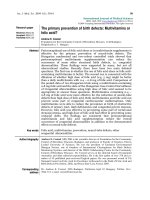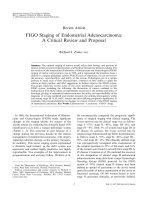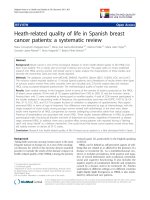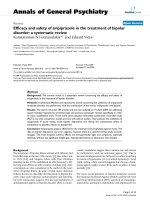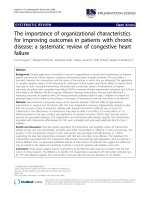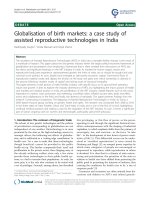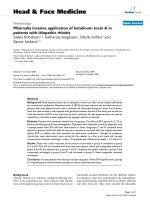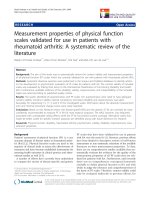Application of artificial intelligence in screening of birth defects a scoping review
Bạn đang xem bản rút gọn của tài liệu. Xem và tải ngay bản đầy đủ của tài liệu tại đây (453.35 KB, 58 trang )
MINISTRY OF EDUCATION
MINISTRY OF HEALTH
HANOI MEDICAL UNIVERSITY
____♦♦♦____
HUY DO DUC
APPLICATION OF ARTIFICIAL INTELLIGENCE IN
SCREENING OF BIRTH DEFECTS: A SCOPING REVIEW
GRADUATION THESIS
DOC TOR OF PREVENTIVE MEDICINE
2015-2021
SUPERVISOR:
LE MINH GIANG, MD, PhD
HANOI-2021
ACKNOWLEDGMENT
I would like to offer my thanks to the staffs of Hanoi Medical University.
School of Preventive Medicine and Public Health, as well as teachers from the
Department of Epidemiology for your guidance and support.
I would like to express my great appreciation to all the individuals and teams
below, that without them. I would not be able to accomplish my graduation thesis.
Firstly. I would like to express my deepest gratitude to my supervisor.
Assoc.Prof Le Minh Giang for his guidance. Even though he has always been busy,
he still willing to give me some of his precious time. This has always been very
much appreciated.
The second and third person that I want to say thanks to is A/Prof. Nguyen Thi
Trang and Ms. Le Thi Minh Phuong from Department of Biomedical Genetics for
your help in birth defects, especially Ms. Le T1Ũ Minh Phuong for the time you
spent screening articles with me.
In addition, because I can always ask you about scoping review, thank you
Ms. Nguyen Thi Hue from Center for Research and Training on Substance AbuseHIV.
Last but not least, I would like to give thanks to my family and close friends,
for their support and encouragement throughout my study.
Hanoi. May 2021
Do Due Huy
COMMITMENT
Respectfully addressed to:
Board of Hanoi Medical University
Board of Preventive Medicine and Public Health School
Department of EpidemiologyBoard of Dissertation Assessment
My name is Do Due Huy - Student of Hanoi Medical University, course 2015
- 2021. majoring in Preventive Medicine Doctor, hereby declare that:
This is a research that I conducted under the scientific guidance of Assoc.Prof
Le Minh Giang. The data and results presented in the research are completely
truthful. In addition, die thesis also uses a number of comments, assessments as
well as results from other authors, agencies and organizations, all with source
annotations clearly stated in the references.
I will take full responsibility if tliere was any' fraud in the contents of my
research.
Do Due Huy
Hanoi. May 2021
ABBREVIATIONS
AI
Artificial Intelligence
SVM
Support Vector Machine
ANN’S
Artificial Neural Networks
AFP
Maternal Serum Alpha-fetoprotein
PAPP-A
Pregnancy-associated Plasma Protein A
NIPT
Non-invasive Prenatal Screening
TM/ V*:
-u
TABLE OF CONTENT
ABSTRACT................................................................ .........................................
1.3.1.................................................
1.3.2--------------------------------------------Definition ..........................
.........---------------------------------------........... 16
1.3.3
Machine learning.
MATERIALS AND METHODS
.
. 17
••••••»•••••••••••••••••••••••••••••••••
••••••••• 21
3.1 Protocol and registration................... ..................................................
21
3.2 Study subjects
21
3.2.1 Inclusion criteria
.21
3.2.2 Exclusion criteria
21
3.3 Information sources
22
3.4 Search
22
3.5 Selection of sources of evidence----------------------------------------------- .23
3.6 Data charting
3.7 Data Items
•• •• • ••••••••••• •• •••••••••••• •• • •• • • • ••••••••• •• • •••••••••• • ••••••• • • • • • • • •• •• • •••••••• •
•• ••
2.33 Evaluate the effectiveness of artificial intelligence software .... 19
3.8 Synthesis of results.............. ..................................................................
RE SITT.....................................................................................................
4.1 Results of articles search
4.2
4.3___________
.. 23
23
24
25
25
4.4
LIST OF TABLES
4.5
Table 2.1 The risk of Down. Edward and Palau Syndrome according to
maternal age.......................................................................................................... 6
4.6.................................................................................................................................
4.7.................................................................................................................................
4.8
LIST OF FIGURES
4.9.................................................................................................................................
4.10
TM/ V*:
4Ả VỈX
8
4.11
ABSTRACT
4.12 Introduction: There are many advantages of artificial intelligence in
healthcare setting compared to human clinicians. However, the readiness of Al to
replace human as a stand alone screening program is remain unknown
4.13 Method: We conducted a scoping review, a structured evidence synthesis
describing a broad research field, to summarise knowledge on Al evaluated for birth
defects screening and to assess Al’s ability for adoption in birth defects screening in
2010-2020 period. Data were collected through PubNied database using a
combination of keywords which was agreed by three different reseachers.
4.14 Result: There were 11 eligible studies. All Al models built in these studies
archieved encouraging results. However, there are still key evidence gaps that need
to be addressed before Al can be rendered more transferable to large- scale
screening evaluations.
4.15 Conclusion: We found that die published evidence on Al application for birth
defects detection was concentrated around model (algorithmic) development,
generally independently of real-world clinical or screening evaluation, and overall
the evidence does not indicate readiness of Al systems for real-world birth defects
screening trials.
4.16
Keywords: Artificial Intelligence; Birth Defects;
Screening
4.17
4.18
INTRODUCTION
There are about 303.000 newborns who died within 4 weeks of birth
every year, worldwide, due to congenital abnomalies*. In the vs. for every 33
babies bom. there is 1 with a birth defect*'. Birth defects can have lasting effects,
with devastating consequences not only for the child, but also for the family, the
health system, and society as a whole*. Early screening methods for intervention
and treatment can be implemented to limit the complications of birth defects in
order to improve quality of life for children and families as well as reducing infant
mortality due to birth defects3. Therefore, we need to have effective methods to
screen, diagnose and predict birth defects so that we can ha\e early interventions.
4.19
In recent years, artificial intelligence (Al) has become an important
part of our daily life. Some applications of artificial intelligence in everyday life
include Google Translate". Google Map5. Youtube video proposal software6. ...In
healthcare, artificial intelligence lias many important applications such as screening
for cancer or building predictive models in disease prevention . Application of
artificial intelligence to build clinical decision support system is of interested to
many scientists around the globe3. The advantages of Al includes promoting
evidence-based diagnostics, improving diagnostic efficiency, individualizing
treatment as well as bringing high economic efficiency9,10.
4.20
With these advantages, the application of artificial intelligence in
prenatal screening can be an effective tool to help central hospitals to make more
accurate diagnosis of prenatal birth defects as well as replacing doctors in lower
level hospitals where there are no trained specialists. Therefore, it is necessary' to
assess the ability' of artificial intelligence systems to screen for birth defects based
on existing literatures and identify' gaps in these studies. However, there are not
many studies mentioned this issue. Thus, we conducted tills study with 2
objectives:
4.21
Objective 1: To describe characteristics of current studies in the 2010
- 2020 period on the application of artificial intelligence in screening of birth
defects in pregnant women.
4.22
defects.
Objective 2: To assess Al's readiness in large scale screening of birth
4.23
4.24
LITERATI RE REVIEW
2.1 Scoping review
4.25
Since The 1970s. the term systematic review has begun to appear in
researches as a wav of accessing, analyzing and interpreting the results or implications of
multiple studies at the same time’- 1. However, in many cases, systematic review is not able
to provide necessary informations to readers. Then, scoping review, with a different
approach lias become a more relevant direction'* 2. For example, researdiers may choose a
scoping review when they need to find out about knowledge gaps in a particular field,
something that systematic review cannot provide.
4.26
The term "scoping review" is an ideal means of determining the coverage of a
document on a particular issue and giving clear indication of the number of studies
available as well as generalizing the concentration of studies to that problem 15'*4. Although
similar to systematic review that scoping review follow a pre-built process, they are done
for different purposes1’. It can be used to synthesize concepts about a particular area of
study, along with clarifying the definitions or conceptual boundaries of a topic 10. Along
with that, the scoping overview can be the foundation for a systematic review study,
especially in the case when we need to learn about a new topic but there are still a lot of
unanswered questions1 . We can distinguish between scoping reviews and systematic
reviews based on research questions. If the authors have a question regarding the feasibility,
appropriateness, meaningfulness or effectiveness of a certain problem, then systematic
renew is likely the most valid approach 15. However, if they don't ask such precise question,
and want to explore the certain characteristics/ concepts in previous studies, or simply
reporting and discussing about these problems, then scoping review is a better choice.
4.27
2.2 Birth defects
4.28
2.2.1 Definition
4.29
Congenital anomaly (Birth defect or Congenital Disorder or Congenital
Malformation), is defined by many authors using different factors depending on their
purposes, but they all agree on the following points:
-
All are abnormalities that have a prenatal cause.
-
These abnormalities may manifest at the bodily, cellular or molecular level.
-
These abnormalities manifest at birth or in later stages.
4.30
Thus, birth defects are all abnormalities at the bodily, cellular or molecular
level, which can manifest at birth or at a later stages but have a prenatal cause. 19
4.31
2.22 Classification of birth defects
4.32
There are many ways to classify birth defects, but we introduce a
classification system based on ICD- 10:
-
Q0O-QO7 Congenital malformations of the nervous system
-
Q10-Q18 Congenital malformations of eye. ear. face, and neck
-
Ọ20-Q28 Congenital malformations of the circulatory system
-
Q30Q34 Congenital malformations of the respiratory system
-
Q35-Q37 Cleft lip and cleft palate
-
Q38-Q45 Other congenital malformations of the digestive system
-
QS0-Q56 Congenital malformations of genital organs
-
Q60-Q64 Congenital malformations of the urinary system
-
Q65-Q79 Congenital malformations and deformations of the musculoskeletal system
-
Q80 Ọ89 Other congenital malformations
-
Q90-Ọ99 Chromosomal abnormalities, not elsewhere classified
4.33
2.23 Cause of birth defects in human
4.34
Causes of birth defects are divided into 3 groups by many authors, including:
(1) caused by genetic factors. (2) caused by environmental factors, (3) caused by multiple
genetic factors. In addition, there are many birth defects with unknown causes.
4.35
a. Birth defects caused by genetic factors
4.36
Birth defects caused by genetic factors are divided into two groups which are
birth defects caused by chromosome disorders and birth defects caused by single gene
mutations.
-
Birth defects caused by chromosome disorders:
4.37
Chromosomal disorders are changes in chromosome number, structure, or
mosaic, resulting in the addition or loss of genetic material. In this group, aneuploidy of
chromosome 21 (trisomy 21), also known as Down’s syndrome, was the most common. In
addition, there are some other common birth defects such as Patau syndrome. Edwards.
Turner. Klinefelter ...
-
Birth defects caused by single gen mutations:
4.38
There are many single gene mutations that cause the genetic birth defects and
its expression obeys the genetic law's of Menden. Single-gene diseases have 3 types of
genetic mechanisms. which are autosomal dominant, recessive and sex-linked. There are
more than 6.000 types of single-gene mutations that have been described 20, of which brittle
X chromosome syndrome is the most common genetic cause of mental retretness. In
addition, there are also defects such as skeletal dysplasia, cartilage dysplasia, cartilage
hypoplasia, microcephaly, colorblindness, hemophilia A ...
4.39
b. Birth defects caused by environmental factors
4.40
- Maternal age
4.41
The risk of having a chromosomal abnormality increases with maternal age.
mainly due to events in the fecal process, resulting in die fetus having a trisomy 21:
4.42 Materna 4.43
l age
21
4.46 15-19
4.47
Trisomy
4.44
Trisomy 1 s
Trisomy
1 : 17000
4.45
13
4.49
1 : 1600
4.48
4.50
20-24
4.51
1 :1400
4.52
1 :14000
4.53
1 : 25000
4.54
25-29
4.55
1 :1100
4.56
1 : 11000
4.57
1:20000
4.58
30 34
4.59
1 : 700
4.60
1 :7100
4.61
1: 14000
4.62
35-39
4.63
1 :240
4.64
1 :2400
4.65
1: 4800
4.66
40-44
4.67
1 : 70
4.68
1 : 700
4.69
1: 1600
4.70
45 - 49
4.71
1 :20
4.72
1:650
4.73
1: 1500
4.74
Table 2.1 The risk of Down, Edward and Patau syndrome according to
4.75
-
1 :33000
maternal age
Poverty:
4.76
According to World Health Organization (WHO), weak socioeconomic status
is associated with an increased in the proportion of birth defects. Pregnant women in these
countries are more likely to suffer from malnutrition before and during pregnancy, and are
at liigh risk of environmental exposures which are harmful to the fetus such as tobacco,
alcohol, etc. In addition, there are still may limitations in reproductive health care services,
family planning or prevention of congenital syphilis syndrome, congenital rubella in the
health care system... which leads to high proportion of birth defects 22.
-
Nutrition deficiencies:
4.77
A nutrition deficiency diet during pregnancy can affect the risk of having a
child with birth defects. Lack of Phosphorus, Magnesium and other trace elements can lead
to a deformation of the skeleton, causing congenital rickets22.
4.78
An iodine deficient diet during pregnancy can also give birth to a baby uiwth
birth defects. UNICEF believes that iodine deficiency causes brain damage and intellectual
disability20. However, this is also the leading cause of mental retardation which can easily
be prevented20,25. Iodine Deficiency Disorder causes spontaneous abortion, perinatal death,
mental retardation, hearing impairment, etc. Severe iodine deficiency disorder can lead to
cretinism.
4.79
Folic acid is a vitamine (vitamin B9) required for biosynthesis and
methylation of DNA and RNA. It is very' important for cell division, especially at the time
of rapid cell division such as in an embryo. Folic acid is essential for the development of
tile brain and spinal cord during the first 4
4.80
weeks of pregnancy24. Reports indicate that 95% of babies with neural tube defects
occur in mothers with no family history of the disease. There are extensive scientific
evidences linking birth defects with folate deficiency’ and the use of folic acid before
conception with prevention of neural tube defects24.
-
Physical and chemical agents:
4.81
Chemical agents such as pesticides, plant protectors, heavy metals such as
mercury, lead ... can cause birth defects such as eye defects, limb deformities, facial and
mouth defects ... Dioxin can cause birth defects at 2 times higher rate than other agents 25.
4.82
Physical agents such as radioactive substances can influence embryogenesis
while radiation, gamma rays, and ultraviolet rays can also disrupt polymorphic process of
muscle and other organs of the embryo.
-
Microbiological agents:
4.83
Mother infected with viruses during pregnancy such as cytomegalovirus,
herpes-zoster virus, chickenpox, flu ... especially rubella can give birth with birth defects
such as defects of the nervous system, cardiovascular system, calcification in the brain,
microcephaly, mental retardation ...
4.84
Some bacteria such as toxoplasma, chlammydia trachomatis, syphilis ... can
also cause birth defects such as fetal death, cleft lip. calcification in the brain,
hydrocephalus, encephalitis - meningitis, retinitis. ..if the mother has been previously
infected without treatment or infected during pregnancy20.
-
Drinking alcohol during pregnancy:
4.85
Fetal Alcohol Syndrome (FAS) is a syndrome of birth defects in children
whose mothers drink alcohol during pregnancy. This syndrome includes growth retardation,
heart defects, physical, mental and behavioral disorders that can include low IQ or mental
retardation. Fetal alcohol syndrome is not a simple birth defect. It is a group or pattern of
related disorders. The severity of symptoms varies, with some children having worse
symptoms than others. Alcohol can affect the fetal brain at any time during pregnancy.
Hence there is no safe alcohol dosage, no safe drinking time or no right kind of wine to
drink during pregnancy2'.
-
Some other factors:
4.86
Some other factors such as obesity mother, insulin-dependent diabetes, usage
of stimulants such as cocaine, smoking, sedatives (Thalidomide...), antiepileptic drugs ...
are also risk factors that increases the rate of childbirth with birth defects.
4.87
2.25 Screening methods for some common birth defects
a. Ultrasound
4.88
Ultrasound is a non-invasive procedure that does not harm both the mother
and the fems, which allows clinicians gather some information about the pregnancy that
cannot be provided by any examination such as: gestational age. number of fetuses, fetal
development, mother-to-child metabolism quality(based on Doppler) and fetal morphology.
Although there have been many technical improvements, but ulttasound is still not the
perfect method, it can only detect some fetal malformations when the fetus is in a favorable
position with the right amount of amniotic fluid. Unclear morphological abnormalities are
also difficult to detect on ultrasound. For example, in Down Syndrome, ultrasound can only
detect indirect images such as nuchal translucency.
4.89
Ultrasound for tile measurement of nuchal translucency is usually done at 11-
13 weeks of pregnancy which will give the most accurate results. The majority of cases
with nuclial translucency < 3 mm were classified as low-risk (less likely to develop
chromosomal abnormalities). In the case when nuchal translucency is ranged from 3.5 to
4.4 mm. there is a chromosomal abnormality rate of 21.1% and in the case which it is > 6.5
mm. the risk of chromosomal abnormality can be increased up to 64.5%. In cases where
nuchal translucency is > 3 mm. the pregnant woman will be ordered to perform an
additional triple test at 16-18 weeks
b. Double test. Triple test
4.90
The first Down syndrome screening method was imroduced in the 1970s
based on maternal age. women over 40 years old will be given an amniocentesis test to
determine the risk of fetus with chromosomal abnormalities. Later, when amniocentesis
becomes safer than before with the guidance of ultrasound. the cost is also reduced,
amniocentesis is widely indicated in high-risk pregnant women, ie older than or equal to 35
years old.
4.91
Test of biochemical indices in maternal blood
4.92
- Maternal serum alplia-fetoprotein (AFP)
4.93
A developing fetus lias 2 main types of blood protein. Albumin and alpha
fetoprotein (AFP) while an adult lias only albumin, so an AFP test in the maternal serum is
used to indirectly determine the amount of AFP in the fetal blood.
4.94
Normally only a small amount of AFP in the amniotic fluid can cross the
placenta to enter the mother's bloodstream. However, when there is a neural tube
abnormality, because part of The embryonic neural tube is not closed, AFP will escape into
the amniotic fluid. Neural tube abnormalities include anencephaly (due to the neural tube
that does not close the head) and spina bifida (due to the inability of the tail of the neural
tube). In the US. the rate of these diseases is 1-2/1000 births. Likewise. in gastroschisis or
omphalocele, AFP from the fetus enters mother's bloodstream in a larger amount than
usual.
4.95
AFP tends to be lower than normal in fetuses with Down syndrome or some
chromosomal abnormalities, so AFP is useful in screening for Down syndrome and a
number of other infections. A combination of AFP screening and ultrasound can detect
almost all anencephaly and most cases of spina bifida.
4.96
- Maternal serum free Beta-HCG
4.97
This is the most commonly used test during pregnancy. About 1 week after
the embryo implants in the uterus, the amount of beta HCG secreted by the culturing cells
is sufficient to diagnose pregnancy. In the earl}’ stages of pregnancy, beta HCG helps in
early diagnosis and prognosis of miscarriage, ectopic pregnancy because in these cases,
beta HCG is lower than normal.
4.98
Later in pregnancy, at the end of the second trimester. HCG may be used in
combination with AFP to screen for specific chromosomal abnormalities in Down
syndrome. Increased HCG in association with decreased AFP is an implication of Down
syndrome. Meanwhile, abnormally high hCG suggests pseudocyesis.
0.25 MoiM
4.0 MoM
3.0 MoM
10 MoM link
ground
iSUccrnaỉ agv (yc*n>
<>35 MoM
0.50 MoM
BM kgnxmd
Mxcrml Age (yean)
4.99
4.100 Figure 2.1 Maternal age-related risk for trisomy 21 at 12 weeks gestation and
maternal serum b-hCG levels deft) and PAPP-A (right)
-
Maternal serum Estriol
4.101
Estriol is derived from dehydroepiandrosterone (DHEA) which is produced
from the adrenal glands and then converted to estriol by the placenta. Estriol enters the
mother's bloodstream and is excreted in the urinary tract or excreted by the liver into the
bile. Continuous testing of estriol in the third trimester is performed to monitor fetal health
status. If the concentration of estriol is reduced, tile fetus is at risk and may indicate an end
to pregnancy. Estriol is also reduced in fetuses with Down syndrome or adrenal
insufficiency or anencephaly.
-
Pregnancy-associated plasma protein A (PAPP-A)
4.102 In the first trimester, low serum PAPP-A is an indication of trisomies 13,
4.103
1 s and
21. Furthermore,
low PAPP-A levels in the fust
trimester
predict
a low
4.104 binh weight pregnancy or stillbirth. A higher than normal PAPP-A suggests a larger
titan normal fetus.
4.105 Combination of serological tests can potentially increase the sensitivity and
specificity of detecting fetal abnormalities. The classic 3 screening tests includes alphafetoprotein (MSAFP). beta-HCG. and estriol (uE3). Some facilities use fourth tests, which
is inhibin-A.
4.106
4.107 AFP
4.108 UE3
4.110 Neural tube defects
4.111 High
4.114 Trisomy 21
4.115 Low
4.112 Norm 4.113 Nor
al
mal
4.116 Low 4.117 High
4.118 Trisomy 18
4.119 Low
4.120 Low
4.122
4.123
4.109 HCG
4.121 Low
Table 2.2 Diagnosis of abnormalities using AFP, uE3 and HCG
4.124 (The values of these indicators depend on gestational age)
c. Amniocentesis
4.125
Amniocentesis is the most widely used method today because of its technical
simplicity as well as low rate of complications. It is considered the main method of
obtaining fetal specimens.
4.126
Amniocentesis is done at 3 periods: Early amniocentesis (13 to 16 weeks
gestation), classic amniocentesis (from 17 to 20 weeks gestation), late amniocentesis (after
20 weeks ).
4.127
The best gestational age for this procedure is 17 to 18 weeks because at this
time the chance to successfully draw out amniotic fluid is highest while the rate of
complications for both mother and fetus is lowest. The procedure is performed under
ultrasound guidance.
4.128
Amniocentesis takes about 20 ml of amniotic fluid for testing. The whole
procedure takes 5 to 10 minutes. Then maternal need to stay in place for 3 hours, she
doesn't have to use antibiotics. Risk of amniotic fluid leakage, miscarriage is < 0.5%. Test
results will be available in 2 to 3 weeks.
-
Chorionic Villus Sampling
4.129
Chorionic villus sampling (CVS), or chorionic villus biopsy, is a prenatal test
that involves taking a sample of tissue from the placenta to test for chromosomal
abnormalities and certain other genetic problems. T1ŨS method causes high rate of
miscarriage (about 9%), so it is only used mainly in cases of fetus with severe
abnormalities detected in the first trimester. This method is performed under ultrasound
guidance. Results will be available after 5 to 7 days.
-
Non-invasive prenatal screening (NIPT)
4.130
This is considered to be the most effective and safest testing method available
today. The method is performed early from the 10th week of pregnancy through the
mother's blood sample (only 7-10 ml). Chromosome abnormalities can be screened include
chromosome 6, 9. 13 (Palau's syndrome), chromosome 18 (Edwards), chromosome 21
(Down), chromosome X. Y. and segmental mutations, etc. In addition. Illis method is also
applicable for single pregnancy, twins. surrogacy with high aocuracv, up to 99.98%.
4.131
Prenatal screening not only helps detect birth defects for the fetus, but it also
enhances and improves the quality of fiiture generations. Therefore, prenatal screening and
diagnosis is an essential job to help mothers detect diseases, have healthy babies which
develop normally.
4.132
At the present, modern molecular biology- techniques such as NGS,
microarray. BoBs can screen and identify- many genetic mutations. Especially the NGS
technique can decodes the entire human genome to identify' genetic abnormalities related to
birth defects. This technology help US detect 4500 different genetic diseases. Therefore, it
is necessaty to have machine learning and deep learning technology in order to promote the
effectiveness of these systems.
4.133 2.3 Artificial Intelligence (.Al)
4.134 2.3.1 Al application in health care
4.135
In clinical setting. Al is often used to build clinical decision support system.
Clinical decision support systems haw the responsibility of assisting physicians or
healthcare professionals in making clinical decisions. These systems can improve the
quality of healthcare by providing references to doctors based on data from the past.
4.136
Clinical decision support systems have been developed since the 1970s, such
as the MYCIN. INTERNIST-1 and CASNET. Decision support systems have been
developed and applied in many fields of healthcare such as diagnosing diseases, developing
treatment regimens, making drugs, monitoring and taking care of patients.... These systems
have been applied in many facilities around the world. Al algorithms in healthcare have
been developed by many companies, including large companies such as IBM. Microsoft.
Google. Intel. Facebook and even startups. In recent years, the development and application
of clinical decision support systems have been increasingly strengthened. There are many
reasons for this development, that is the development of hardware leading to increased
computing power. shortening The time to collect and process data; the volume of medicalrelated data collected from medical and personal devices is increasing; development of
genetic databases: electronic medical record management systems are becoming more and
more popular: development of highly accurate advanced Al techniques (such as deep
learning methods) in the fields of computer vision and natural language processing
enhances the accuracy of Al system 2.32 Definition
4.137
Artificial Intelligence (Al), also known as Al. is the intelligence expressed by
machines, different from the natural intelligence expressed by humans or animals, which
are related to consciousness and emotions.
4.138 In other words, artificial intelligence is a branch of computer science whose
purpose is to give software the ability.- to analyze information, then make decisions based
on results.
4.139
The artificial intelligence concept is built based on 2 different ideas. The first
idea is aritificial narrow intelligence (also known as ANI). These are Al softwares that can
do a specific job like voice recognition or selfdriving cars or sorting spam messages.... Tire
second idea is about artificial general intelligence (artificial general intelligence), also
known as AGI. This is the purpose of building artificial intelligence, which is to create
software that can do everything humans can or even more. Today, almost all new Al
inventions belong to ANI.
4.140 2.3.3 Machine learning
4.141
Machine learning is the most important part of Al. it gives computer systems
the ability to learn automatically. Machine learning can be understood as the process by
which a system "learns" itself from past experiences and converts those "lessons" into its
knowledges, instead of using knowledges obtained by human.
4.142
Currently, two definitions of machine learning method have been proposed.
First definition by Arthur Samuel describes this approach as "the field of study that gives
computers the ability to learn without being explicitly programmed." This is the old and
unofficial definition. Instead. Tom Mitchell proposed a more modern definition: “A
computer program is said to leani from experience E with respect to some class of tasks T
and performance measure p if its performance at tasks in T. as measured by p improves
with E”. For example, computer-based chess, where E is the experience from playing
previous games. T is the task of playing chess, and p is the probability that the software will
win the next time it is played.
4.143
Any machine learning method can be categorized into one of two types:
supervised learning or unsupervised learning.
4.144
a. Supervỉsỉed learning
4.145
As
children,
we
learned
to
classify
new
things
under
guidance
that
bark
of
and
adults.
tell
US
They
that
point
itsoftware
is
at
aadog.
furry
Through
four
leg
many
creature
such
instructions,
other
animals.
we
This
get
is
to
the
know
core
how
concept
to
identify
of
supervised
a
dog
among
machine
leaning.
already
know
In
this
how
method,
correct
the
output
should
is
look
given
like,
a
data
having
set
the
and
idea
tliat
there
is
a
4.146 relationship between the input and the output. The task of a supervised machine
learning mechanism is to try to find the relationship between the input data and the desired
output, and then use that relationship to predict the output for the new input.
4.147
The supervised machine learning method is divided into two types of
problems, regression and classification. In a regression problem we are trying to predict
results within a continuous output, meaning that we are trying to map input variables to
some continuous function, for example, forecasting prices for a specific house from input
data such as area, number of floors, etc. In a classification problem, we are instead trying to
predict results in a discrete output. In other words, we are trying to map input variables into
discrete categories. For example, pr edicting if this person lias cancer based on a series of
pictures.
4.148
Tire advantage of the supervised machine learning method is that it can find
out the correlation between input and output data that is close to reality and has good
coverage of different cases. However, the disadvantage of machine learning methods is that
large input data is required, and the data must be pre-labeled, which can be expensive in
terms of time and money. In addition, in order to have a good coverage of the different
cases, the input data must be diverse and need to be updated continuously, because
although it is called a cat. the cats in different places are different in shape, size, color, and
sometimes we have to ask ourselves if it’s a cat, which is the same in this machine learning
approach.
4.149
4.151
4.152
4.150 Figure 2.2 Example of an supervised learning system
b. Unsupervised learning
4.153 Unsupervised machine learning is used when we know little or no what the
outcome will be. While in supervised machine learning, we try to build a predictive model
based on labeled input data, in the unsupervised learning method, instead of available
labelled data, the model collects data from the environment and labels them itself, just like
children who are able to imitate the actions of adults, classifying other animals by
themselves, or come up with rules of a game based on observations.
4.154 The advantage of the unsupervised machine learning approach is that it does
not need labeled data, and it can provide unknown information from the input data, as well
as automatically classify' the data by finding different characteristics from the data itself.
However, this method lias disadvantages such as it takes many steps to build, and it is
difficult to understand what is going on inside the software or what method it is using to
learn.
4.155 2.33 Evaluate the effectiveness of artificial intelligence software
4.156
In order to classify' whether a pregnant woman has fetus with birth defects,
we have to answer a yes or no question, or in other words, positive or negative. There are 4
possibilities when comparing the software's prediction with fetus’s true condition. If the
prediction says that this case is positive and in fact this person is positive, this is called a
true positive, but if in fact this person is negative, it is called a false positive. Conversely,
true negative occurs when both the prediction and fetus's true condition are negative, and
